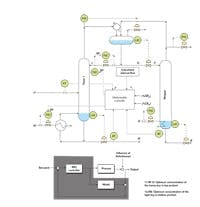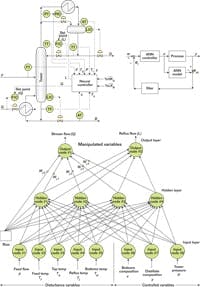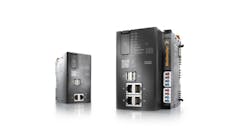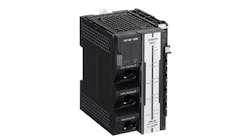By Béla Lipták
Globally, more than 80 million barrels of crude oil are refined daily. The amount of energy used for distillation is approximately 8% of the total energy used in the industrial sector of the United States. American refineries spend 50 to 60 percent of their operating costs (i.e., excluding capital costs and depreciation) on energy, in Venezuela, Russia and the Middle East that number is even higher, about 70%. Compared to refineries, the much more advanced chemical industry spends only 30 to 40%. This difference shows the savings that can be obtained just by implementing the state-of-the-art controls and optimization described in this series.
A model-based, multivariable control system requires the development of dynamic models based upon fractionator testing and data collection. These dynamic models predict future fractionator performance based on the memorized past performance. Model-based multivariable control can be valuable for towers that are complex, subject to many constraints and experience severe interactions.
In the case of well-understood processes, such as distillation, the material and heat balance relationships are combined into this overall dynamic model. Once a process model has been established, the controller is simply the inverse of that model. In this sense, the PID controller is a linear inverse model of a single loop. A simple internal model-based controller (IMC) is shown at the bottom of Figure 1. It has the same structure as the Smith predictor described in the first part of this series of articles, which consists of a first-order system with dead time in combination with a PI controller. (See Part 1, Control, November, 2006, p. 16)
Figure 1
Multivariable internal model controls (IMC) for controlling two product compositions while keeping the operation within the constraints of the process equipment and while taking into account interactions and the dead time introduced by the stripper.
In this case, the two towers have two products and an impurity stream. The objective is to control the composition of both products and therefore, when an adjustment is made in response to an upset in the composition of one, that manipulation tends to cause a disturbance in the operation of the other composition loop. In this example, the MVC controls the two product compositions, while keeping the operation within the constraints of the process equipment capacities and makes its corrections while considering the dead time introduced by the stripper.
In this process, the feed flow rate is the main disturbance variable. The steam to the first column and the temperature at the top of that column are the manipulated variables. A constraint variable is the internal reflux flow, which is calculated from the tower temperatures and flows.
Dynamic Matrix Control (DMC) is another MVC technique using a set of linear differential equations to describe the process. The DMC method obtains its data from the response of the column to upsets, and after the model is so obtained, calculates the required manipulations utilizing an inverse model. Coefficients for the linear equations describing the process dynamics are determined by actual testing. During these tests, manipulated and load variables are perturbed and their dynamic responses are observed. This identification procedure is time-consuming and requires substantial local expertise.
Artificial Neural Networks (ANN)
Figure 2 shows a three-layer, back-propagation ANN, which predicts the manipulated steam and reflux flows of a column. The process model is stored by the way its processing elements (nodes) are connected and by the importance that is assigned to each node (weight). The ANN is trained by example and, therefore, it contains the adaptive mechanism for learning from examples. During the training of these networks, the weights are adjusted until the output of the ANN matches that of the real process. Naturally, when process conditions change, the network requires retraining. The hidden layers help the network to generalize and even to memorize.
In the single-input/single-output (SISO) configuration, the ANN network builds an internal nonlinear model relating the controlled and manipulated variables. It builds this model by learning or training, based on a data set of past measurements and process responses. This makes the neural controller more useful and more robust than the standard PID.
Because the neural network paradigm can accommodate multiple inputs and outputs, an entire fractionator model can be built into a single controller. The neural controller can be thought of in the same terms as model-based control algorithms, whereby the neural network is used to obtain the inverse of the process model. As shown on the top right of Figure 2, the back-propagation network can be trained to behave as an inverse model of the process, with load and controlled variables being input and output vectors.
To build such a model, all inputs and outputs must be normalized based upon expected minimum and maximum values and presented to the network during training. By using such historical data, the network is trained and a nonlinear internal model is created. The networks ability to do the prediction of the dynamics of the fractionator improves as more data become available for training. Thus, the neural controller is a type of nonlinear, multivariable, model-based control algorithm. The difference is,that, instead of creating the nonlinear process model with explicit equations, the neural controller builds its own process model based on the actual operation of the tower.
Since the neural controller is an empirical, rather than a theoretical model, it is susceptible to errors if operated outside the conditions that existed during training. Operating data, therefore, must be gathered continually, and the network retrained whenever novel conditions occur in order to increase the robustness of the neural controller throughout its life of operation.
Sub-Optimization
Every distillation column is unique. The goal of optimization of a single column is to safely operate at maximum profit. To do this requires the knowledge of the market values of each product. If the products of a column are not final products, but are the feed flows to other unit processes, these market values might not be known.
In such cases, the goals of optimization change. The criterion becomes the generation of the required products at minimum operating cost. This minimum cost can be an optimum with respect to the column involved, but it is only a sub-optimum with respect to the total process of which the column is a part.
Figure 2
The configuration of a back-propagation neural network (ANN) and its use as an internal model controller.
When the market is unlimited and sufficient feedstock is available, the optimization of the column requires the determination of both the optimum separation and the value of the feed stream(s). As a function of these values, the goal can either be maximum loading or maximum energy efficiency.
When determining maximum loading, one of three constraints can be the limiting one. Throughput can be limited by:
- The maximum cooling capacity of the overhead condenser;
- The maximum heat input capacity of the reboiler;
- The maximum separation rate of the column itself.
In some cases, the constraint will change with ambient conditions, product prices and other independent variables. Therefore, the design of an optimal control system for a single column should follow three logical steps:
- Designing the basic controls to regulate the operating variables, such as pressures, temperatures, levels, and flows.
- Configuring the controls to regulate the reboiler heat input, the internal reflux flow rate, feed enthalpy, and the sources of heat to the reboiler and pre-heater(s).
- Determining the controls required to maintain the specified separation.
If the above control loops are provided for a single column, that column is sub-optimized. Operation at this sub-optimum will generate products at close to the specified separation, but that separation might not be ideal with regard to the total system. If product purities are higher than specified, the operation is not considered to be sub-optimum.
The Total Model
It is possible to design a control system which will compensate for changes in any of the load variables: feed rate, composition, enthalpy, reflux and bottoms enthalpy. The goal of these systems is to eliminate interactions and to protect the column from the consequences of changes in ambient conditions. To provide a model that describes both the material and energy balance of the column, one has to develop both the steady state and the dynamic equations for the following:
- Feed enthalpy balance,
- Bottoms enthalpy balance,
- Internal reflux computation,
- Reboiler heat balance,
- Overall material balance.
Béla Lipták is a control consultant, editor of the Instrument Engineers Handbook, and former adjunct professor at Yale University. He can be reached at [email protected].

Leaders relevant to this article:





